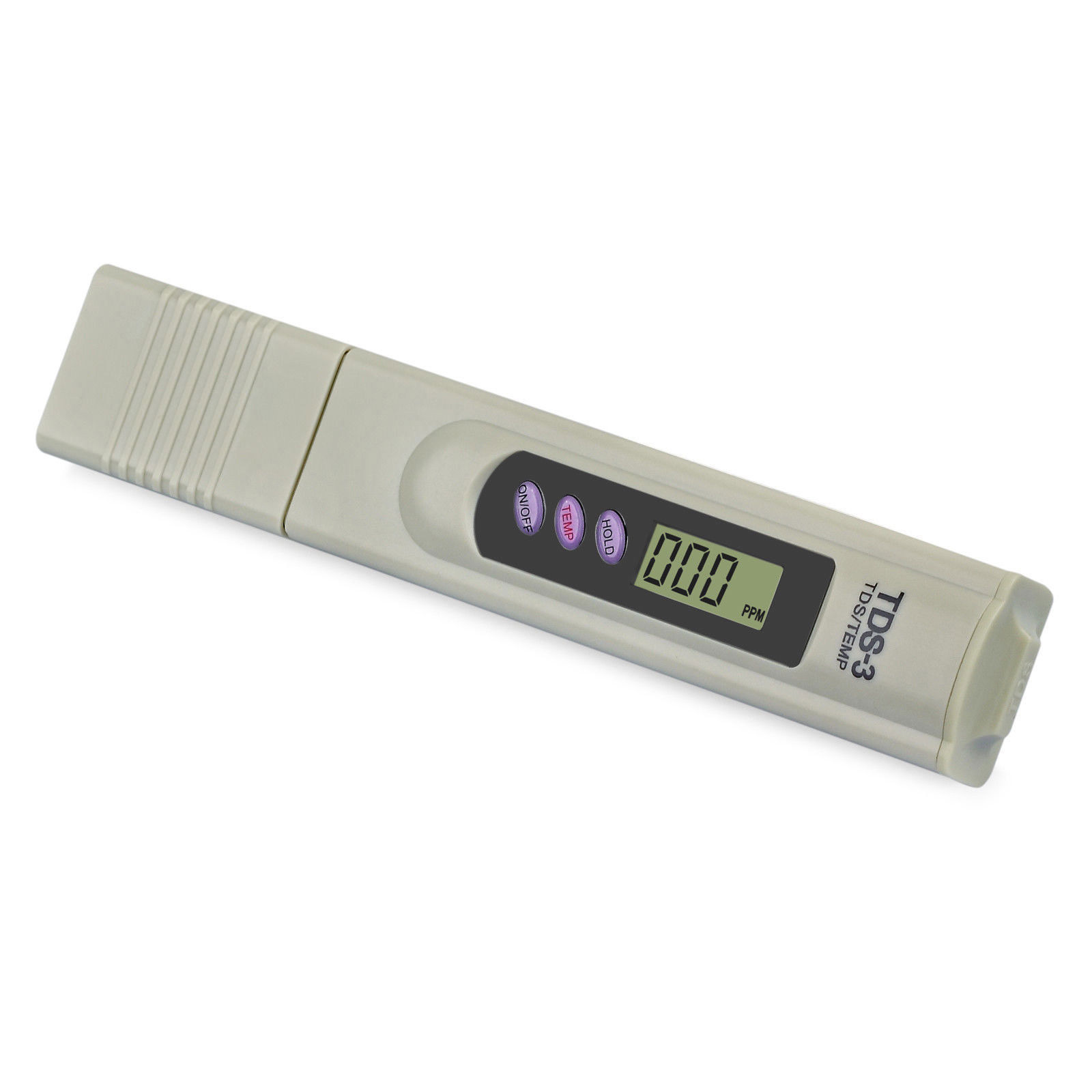Search for your product name or keyword
TDS Total Dissolved Solids Meter

Total dissolved solids (TDS) are the total weight of all solids (minerals, salts, and metals) that are dissolved in a given volume of water. A Total Dissolved Solids (TDS) meter measures the concentration of dissolved inorganic substances in water, expressed in parts per million (ppm). The higher the TDS level, the greater the probability of harmful contaminants.
This TDS Total Dissolved Solids meter can be used to:
- Check the performance of your water filter or water purifier
- Test for water hardness (1 grain = 17ppm)
- Monitor the quality of your drinking water
- Monitor pools, spas, aquariums and hydroponics
Taking TDS Measurements
- Remove the protective cap.
- Press the On/Off button to turn the TDS meter on.
- Submerge the end of the meter into the water/solution no higher than the end of the ridged plastic. About 1″ is plenty. Do not submerge the entire TDS meter in water or dip beyond the maximum immersion level (approximately 1.5″). It is not water-tight and will be damaged if water enters the unit.
- Lightly stir the meter to dislodge any air bubbles.
- Wait until the display stabilizes. Once the reading
stabilizes (approx. 10 seconds), press the HOLD button
to view the reading out of the water. - If the meter displays a flashing ‘x10’ symbol, multiply
the reading by 10. - After use, shake off any excess water from yourmeter. Replace the cap.
Taking Temperature Measurements
- Once the meter is on, the temperature function can be
used at any time, in or out of liquid. - Press the TEMP button. The display will switch to
temperature (in Celsius). Press again to switch to Fahrenheit. - To return to TDS mode, press the TEMP button again.
Changing the Batteries
- Remove the battery compartment by pulling off the top cap.
- Install new batteries (2x LR44 1.5V Button Cells). Be sure
the batteries are properly aligned. - Replace the battery compartment. The meter will turn
on automatically.
Typical TDS Readings Across Different Water Types
Drinking Water Standards
Excellent Quality (0-50 ppm)
- Distilled water, reverse osmosis water, and deionized water typically fall in this range. While pure, these waters may lack beneficial minerals and can taste flat.
Good Quality (50-150 ppm)
- Most bottled waters and well-treated municipal water supplies. This range provides good taste while maintaining low dissolved solids.
Fair Quality (150-300 ppm)
- Acceptable for drinking according to EPA standards. May have a slightly mineral taste but is generally safe for consumption.
Poor Quality (300-500 ppm)
- Still within EPA guidelines but approaching the upper limit. Water may taste noticeably mineral-heavy or slightly brackish.
Unacceptable (500+ ppm)
- Exceeds EPA recommendations for drinking water. May cause digestive issues and has an unpleasant taste.
Specific Water Types
Tap Water: Typically ranges from 50-400 ppm, varying significantly by region and treatment methods.
Well Water: Highly variable, ranging from 100-1,000+ ppm depending on local geology and mineral content.
Bottled Water: Usually 50-200 ppm, with spring water generally higher than purified water.
Pool Water: Maintained around 250-400 ppm for proper chemical balance.
Aquarium Water: Freshwater tanks typically 150-300 ppm, while saltwater tanks can reach 35,000+ ppm.
Important Considerations When Using A TDS Meter
TDS meters measure total dissolved solids but don’t identify specific contaminants. High TDS doesn’t necessarily indicate harmful substances, as it includes beneficial minerals like calcium and magnesium. Conversely, low TDS doesn’t guarantee water safety, as it won’t detect bacteria, viruses, or certain chemicals that don’t contribute significantly to conductivity.
Regular TDS monitoring is valuable for tracking water quality changes over time and determining when filtration systems need maintenance or replacement.
Copyright © 2022-2025 Envistia Mall
www.envistiamall.com
EM-TESTM-0001
